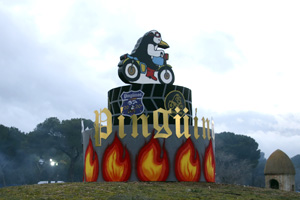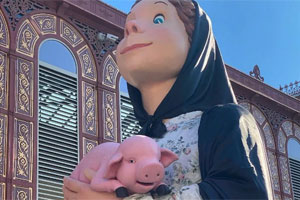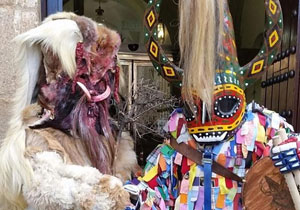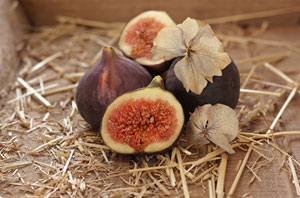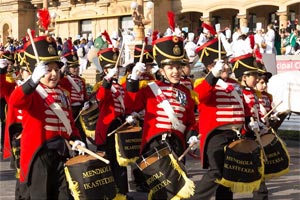Jerez Horse Fair
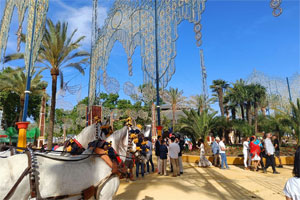
What is the Feria del Caballo de Jerez?
It is held during the second week of May and lasts for a whole week. During this time, the city is transformed into a place full of life, colour and joy, where music, gastronomy, fashion and, of course, horses are the main protagonists. In recent years, it has been extended to nine days to include the weekend before.
The Jerez Horse Fair, also known as the Feria de Jerez or Feria del Caballo, is one of the most important events in the city of Jerez de la Frontera, a city in the province of Cadiz. It is a festival declared to be of International Tourist Interest.
The nerve centre of the fair is the fairgrounds, located in the González Hontoria neighbourhood, where booths and attractions are set up for visitors. The casetas are places where locals and visitors can enjoy food, drink and music in a festive and welcoming atmosphere. In addition, horse competitions, races and equestrian exhibitions are also organised.
One of the highlights of the Jerez Horse Fair is the Horse and Carriage Parade, which is held every day on Calle Larga, one of the main thoroughfares of the city. In this parade, riders and their horses parade in their carriages and traditional attire, while spectators applaud and cheer.
Another important tradition of the fair is the "pescaíto", a lunch on the first day of the fair consisting of fried fish and local wine.
Traditional dress is also an important element of the fair. The riders are usually dressed in short suits and wide-brimmed hats, while the women wear flamenco dresses, with their characteristic ruffles and Manila shawls.
Gastronomy is another of the great attractions of the Jerez Horse Fair. In the stalls you can try typical regional dishes, such as Iberian ham, cheese, shrimp omelette, fried fish and gazpacho, accompanied by local wines and liquors.
The Jerez Horse Fair is a festival that combines tradition, culture, gastronomy and passion for horses, making it an essential event for all those who want to get to know the rich history and culture of Andalusia.
A festival full of colour, music, tradition and joy, which perfectly represents the Andalusian spirit and attracts thousands of visitors from all over the world, who come to Jerez to enjoy its attractions. In addition to the main events, such as the Horse and Carriage Show and the equestrian exhibitions, the fair has numerous activities for all tastes and ages, such as concerts, dances, rides and games for children.
Origin and History
The Jerez Horse Fair has its roots in the Middle Ages, when the city of Jerez de la Frontera became an important commercial and livestock centre in the region. Some historians date its beginnings to 1264. At that time, a livestock fair was held in the city, where all kinds of animals, including horses, were bought and sold.
The Horse Fair in Jerez de la Frontera has a long documented history dating back to the 15th century. In the 19th century, changes began to be introduced in its format, evolving from a livestock fair to an exhibition that included leisure and bullfighting events. For much of the 20th century, it was one of the two fairs held in Jerez along with the Feria de la Vendimia.
In 1985, the City Council decided to demolish most of the fixed stands, allowing new uses to be given to the González Hontoria Park. Nowadays, the Horse Fair has lost some of its traditions, but others are maintained, such as the harness and coachman competitions, stalking and demolition activities, morphological competitions and other activities related to the world of the horse.
Despite the changes over time, the Horse Fair continues to be a celebration of great importance and international recognition. In addition to its history, the fair offers a unique festive atmosphere, where you can enjoy equestrian shows, parades of horse-drawn carriages and riders in typical costumes, as well as the sale and purchase of equines. It is also an opportunity to sample the delicious local cuisine and enjoy an unforgettable experience at one of Spain's most emblematic events.
Over the years, the Jerez Horse Fair has become one of the most important and renowned events in Andalusia, attracting thousands of visitors from all over the world.
What to visit in Jerez de la Frontera
Jerez de la Frontera is a city with a rich history and culture, and has many interesting places to visit and see. These are just some of the highlights:
- Jerez Cathedral: this is an impressive cathedral built in baroque style in the 17th century. Its spectacular dome stands out, as well as its richly decorated interior.
- The Alcázar of Jerez: it is a fortress built in the 12th century, which has beautiful gardens and interior courtyards, as well as an octagonal tower and a Mudejar chapel.
- Plaza del Arenal: is the main square of Jerez, and has a statue dedicated to the local hero, the warrior Alfonso X "the Wise". It is a meeting place and starting point for many events and festivals in the city.
- Wine cellars: Jerez is famous for its wines, and there are numerous wine cellars in the city where you can visit and taste its most famous wines, such as manzanilla, fino and amontillado. Among the most prominent bodegas are González Byass, Tío Pepe, Domecq and Lustau.
- The Royal Andalusian School of Equestrian Art: this is an equestrian training and exhibition centre, where you can see traditional and modern equestrian shows.
- The Archaeological Museum of Jerez: is a museum that houses an important collection of archaeological artefacts from the area, from Roman to medieval times.
- The Barrio de Santiago: is a historic quarter of Jerez, with narrow cobbled streets and whitewashed houses. The Church of Santiago, built in Gothic style in the 15th century, stands out.
The city has much more to offer, from parks and gardens to festivals and cultural events throughout the year.
Crafts and recommended shopping
Jerez is known for its rich tradition of craftsmanship, especially in the fields of leather and ceramics. Some of the recommended purchases in Jerez include traditional ceramic objects from local workshops, such as plates, vases and tiles, which often feature designs typical of the region. There is also a wide variety of leather goods, such as bags, shoes, belts and jackets, available from local shops.
Other recommended purchases include wines and brandies, as Jerez is famous for its production of sherry wines and brandies. Visitors can buy bottles of wine directly from the local bodegas, or visit some of the specialised wine and liquor shops to sample and buy a wide selection of local products.
In addition, lovers of gourmet products can enjoy a wide variety of olives, cheeses and cured meats, which are produced locally and can be found in specialised shops in the city. Overall, Jerez offers a wide range of shopping options to suit all tastes and budgets.
What to eat in Jerez de la Frontera
The gastronomy of Jerez de la Frontera is one of the richest and most varied in Andalusia, with a wide variety of dishes and products typical of the region. Here are some of the most popular and typical dishes of Jerez:
- El rabo de toro (oxtail): this is a stew of oxtail simmered with vegetables and spices, until the meat is tender and tender.
- Lomo en manteca: a dish of pork marinated and cooked in lard, with garlic, bay leaf and paprika.
- La berza jerezana: is a vegetable stew made with cabbage (a variety of cabbage), chickpeas, chorizo and bacon.
- Tuna encebollado: a dish of fresh tuna cooked with onion, garlic, tomato and pepper, with a touch of sherry vinegar.
- La tortilla de camarones: is an omelette made with small fresh shrimps, mixed with egg and flour, and fried in olive oil.
- Gazpacho: a cold soup of tomato, cucumber, pepper, garlic, olive oil and vinegar, served chilled on hot summer days.
- The wines of Jerez: the city is famous for its wines, such as manzanilla, fino and amontillado, which can be tasted in the bodegas and in the city's bars and restaurants.
The city also has a wide variety of tapas and fresh seafood dishes, such as prawns, king prawns, octopus and razor clams. Don't miss the opportunity to sample the rich gastronomy of Jerez during your visit to the city.

